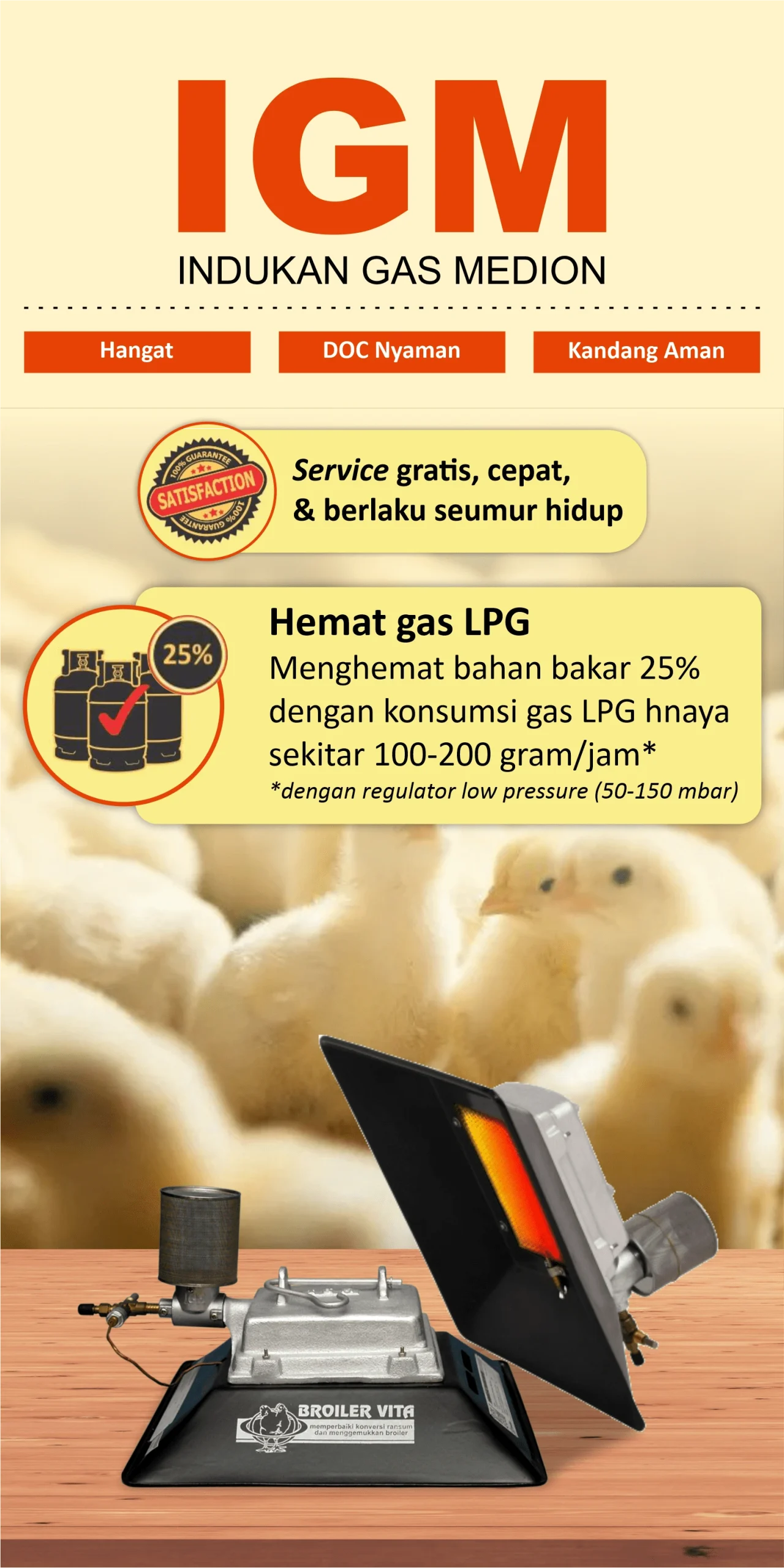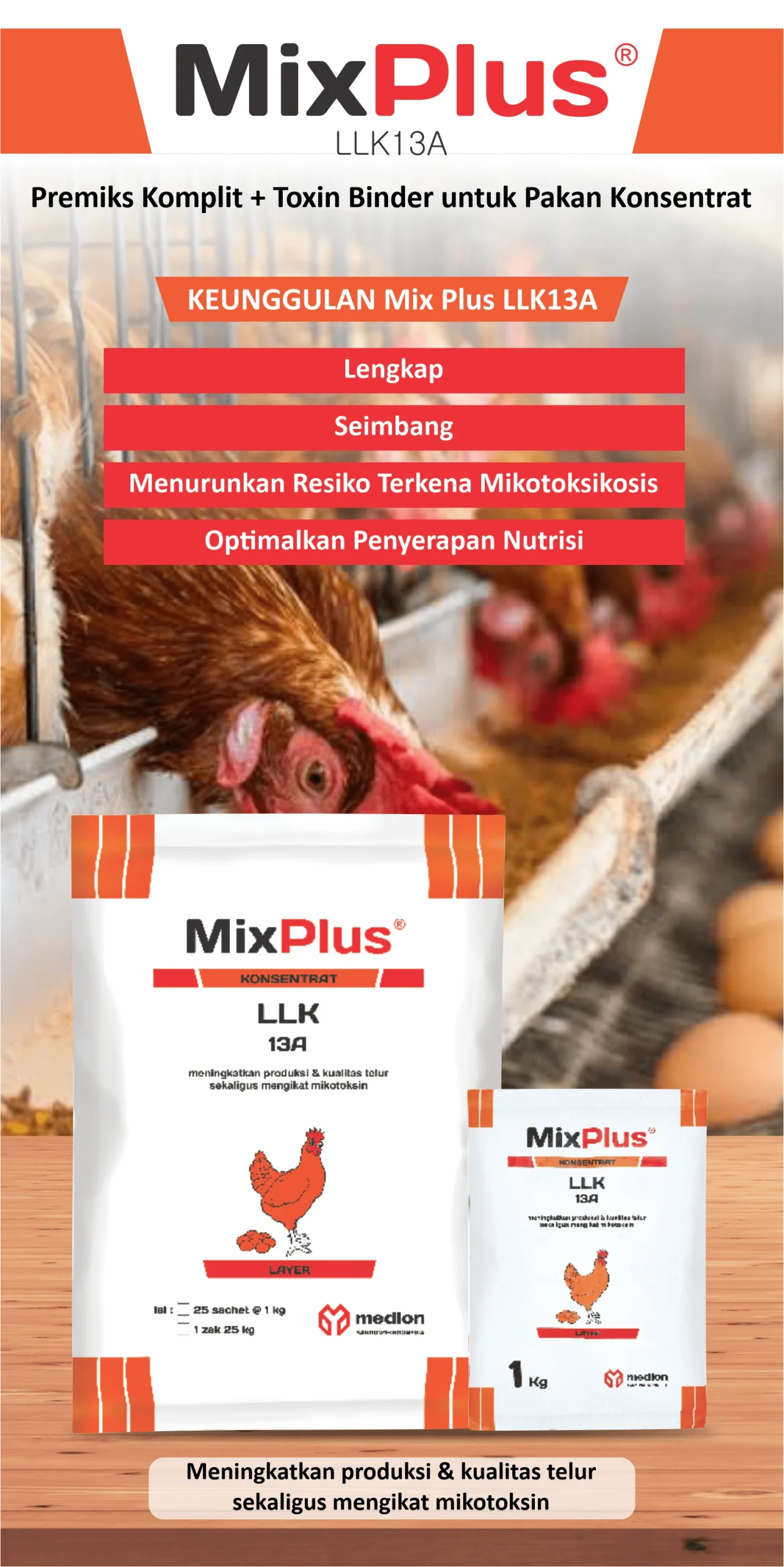Many breeders have proven that by using closed house, they are able to improve livestock performance and have better competitiveness. The ventilation system is the first step in transforming into closed house. Understanding the ventilation system will be a plus for Medion personnel in providing added value for broiler breeders.
Closed House Comparisons
Closed house is a system that is able to provide quality air (composition, speed, and the right amount) and minimize the stress effects so the chicken is comfortable. Parameters that affect chicken growth such as air temperature and humidity can be adjusted according to the chicken’s needs. Closed house can also increase land efficiency with chicken densities of up to 30 kg/m2 compared to open house with a maximum only 16 kg/m2.

Closed House Types
Based on the direction of air movement, closed house can be divided into 2 main types:
1. Closed House Tunnel Type (tunnel)Closed house with an exhauster fan that is placed at the end of the cage (outlet) and at one end, there is an area for air intake (inlet). Air will enter through the inlet, flow along the cage, and finally exit through the outlet fan.
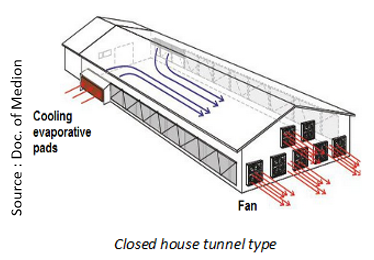
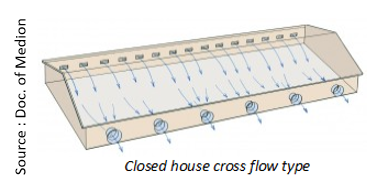
Closed House Main Principle
The closed house system provides comfortable conditions for the livestock by removing heat from the coop generated from the chicken’s body, lowering the intake air temperature (if needed), regulating the appropriate humidity, and releasing harmful gases such as carbon dioxide (CO2) and ammonia (NH3). The above objectives are achieved by using a good ventilation system.
Ventilation System Purpose
There are 3 purpose of the ventilation system:
1. Fresh air change
The closed house system must be able to provide healthy air for chicken, which is air that is rich in oxygen (O2) and emits as much harmful gases as possible such as carbon dioxide (CO2) and ammonia (NH3). Healthy air quality standards in the cage:
- Oxygen levels (O2) > 19.5%
- Carbon dioxide levels (CO2) <0.3% (3000 ppm)
- Carbon monoxide levels (CO) <10 ppmAmmonia levels (NH3) <10 ppm
- Dust levels <3.4 mg / m3
The impact that occurs if the air quality is poor:
- Reduce feed intake
- Chicken weight target not reached
- Increase the risk of dehydration
- Increase the risk of ascites hydrops disease (flatulence with fluid)
2. Cooling effectCooling effect is a decrease in air temperature by utilizing the water evaporation process. Water will take heat energy from the air and evaporate, then lowering the air temperature. The cooling effect occurs in the evaporative cooling pad when the water pump is turned on.
3. Chilling effectChilling effect is the effect of temperature decrease that is felt due to the speed of the blowing wind. The tool that plays role in this effect is the fan. The higher the wind speed that blows, the greater the chilling effect or the lower the effective temperature.
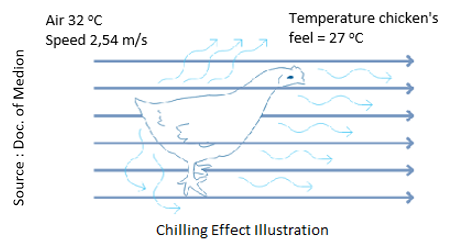
A tool for measuring wind speed is called a wind speed meter. The way to measure wind speed is position the wind speed meter as high as the chicken and measure with a minimum of 3 sampling measurement, in the middle, left side and right side of the cage. The appropriate wind speed for broiler is 0.3 meter / second (brooding period) to 3 meter / second (over 28 days).
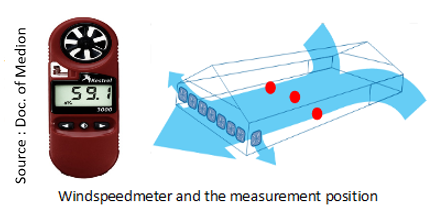
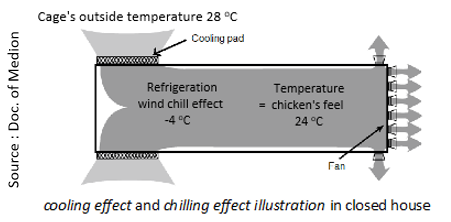
Effective Temperature
The effective temperature is the temperature that the chicken actually feel. Effective temperature is influenced by 3 factors: room temperature, humidity, and air flow velocity in the cage. The effective temperature target for broiler per age that need to be achieved are as follows :
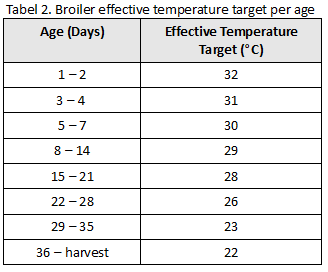
Air humidity (% relative humidity or % RH) is the level of water vapor in the air. Air humidity affects the temperature felt by the chicken. Humid air (contain lots of water vapor) will inhibit the rate of evaporation from the chicken’s body, so that the temperature felt by the chicken will be higher than the room temperature. The higher the humidity value is, the higher the effective temperature the chicken will be feel.To know comfort of the air felt by broiler, it can be seen from the heat stress index, which is an index of the correlation between humidity and room temperature. The heat stress index limit that produces a comfort zone for chicken is in the range 85 – 95. How to calculate the heat stress index:
Heat stress index = temperature (oC) + humidity (%)
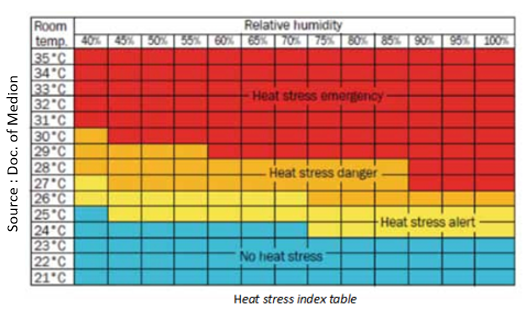
In addition, the effective temperature is influenced by the air flow velocity in the cage. This is related to the chilling effect. The guideline table for the effective temperature felt by chicken due to the effect of% RH and air flow velocity can be seen in table 3.
Air Static Pressure
Static pressure is the pressure given by fluid (liquid or gas) in a system. In using exhaust fans, the difference in air pressure between in the inside of the cage and the outside air must be negative. However, the air flows from high pressure area to low pressure area. Thus, negative static air pressure means that air outside of the cage is drawn into the cage to the exhaust fan.
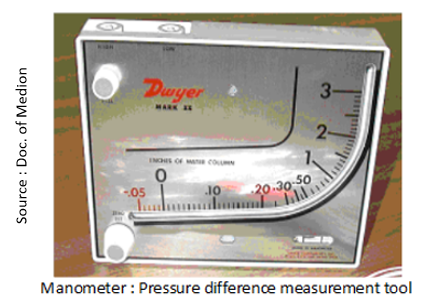
The difference in static air pressure between the inside and outside of the cage must be at least 25 Pa. To achieve this condition, the farmer needs to ensure that there are no holes in the side curtain, building and roof of the cage.
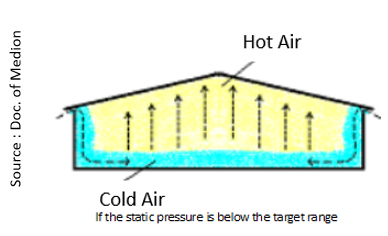
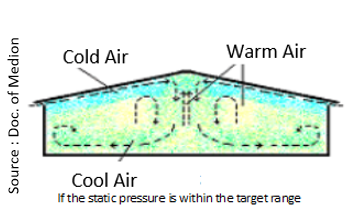
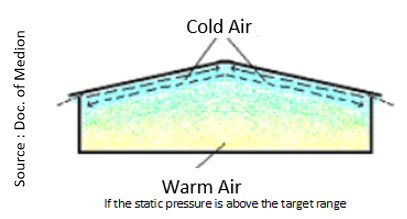
Ventilation System Tools
Providing comfortable air conditions is carried out by the ventilation system which consists of : fan, evaporative cooling pad, controller, and cage curtain.
1. Fan
Fan is a device that creates air movement. In general, there are 2 types of fans: exhaust fan and blowing fan. The exhaust fan function is to suck up air and the blowing fan function is to blow wind. The thrust of the blowing fan is very limited, which is a maximum of 12 meters by a 36 inch blowing fan with a capacity of 20,700 m3 / hour at 50 Pa pressure. So the closed house system use an exhaust fan.Important parameters in fan operation: the number of fan running and the duration of the fan running. Selection of the right fan will result in the appropriate air speed & temperature at minimal electricity consumption.
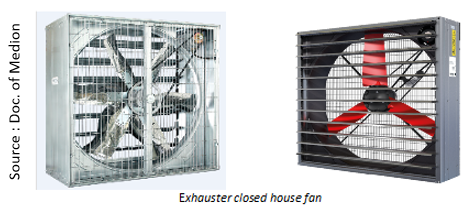
2. Evaporative cooling pad
Evaporative cooling pad is a cage air cooler that utilizes water evaporation. The evaporative cooling pad is connected to a pump that will wet it with water. When the hot air outside the cage enters the cooling pad, the water will take heat energy from the air so the water will evaporate (evaporation process) and it result in a decrease in the temperature of the air that enters the cage. Farmers are not recommended to wet the cooling pad when % RH> 75%, because it will increase the humidity in the cage.
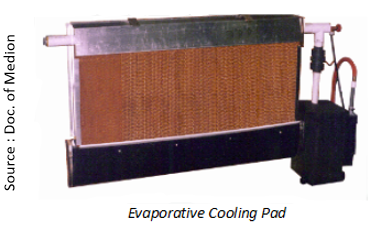
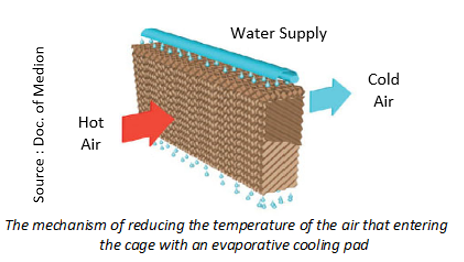
The cooling pad also functions as a filter for air that enters the cage. Cooling pad bulkheads prevent air impurities (large size) from entering the cage, so that the incoming air is cleaner.
3. Cage curtain
The cage curtain is a side of the cage cover so the chickens are protected from outside disturbances. Some of the benefits of cage curtain:
1) Help maintain the air temperature in the cage (especially during the brooding period).
2) Prevent direct wind exposure to the chicken’s body.
3) Prevent rainwater splashing.
4) Provide emergency ventilation if power failure (fan failure).
5) Generate the static pressure required in closed house system.The cage curtain are combined with a winch (pulley) system, to make it easy to quickly raise or lower the blinds with just one operator.
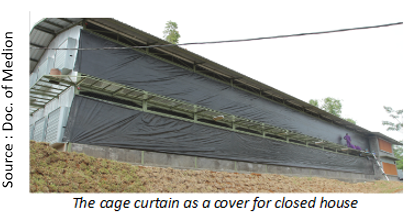
4. Controller
Controller or climate controller is a tool for controlling temperature and humidity in the cage. The controller monitors temperature and humidity and regulates the on or off of the cooling pad fan & pump.
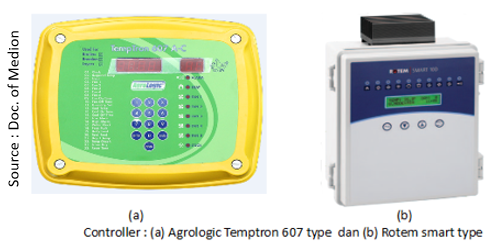
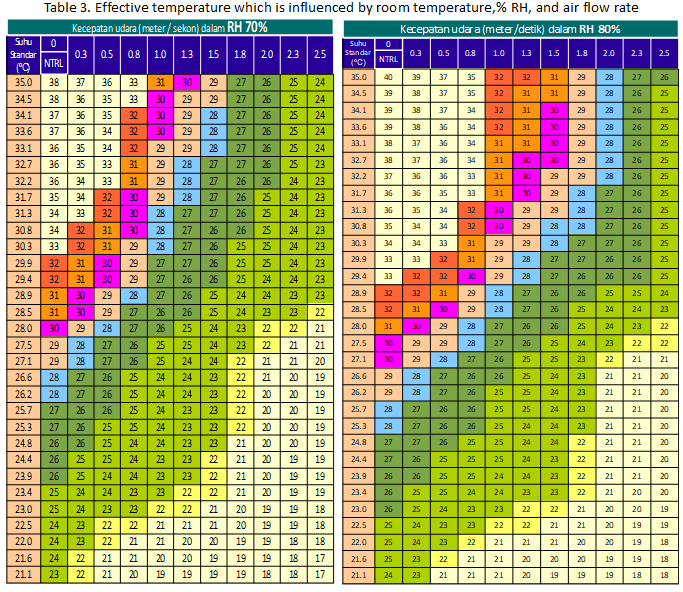
References
CPI PE. 2016. Membangun Kandang Closed House.
Cobb. 2012. Broiler Management Guide.
Marteen de Gussem. 2015. Broiler Signals (halaman 27). Netherlands: Roodbont Publishers.
https://www.decodedscience.org/why-does-damp-cool-weather-make-it-feel-colder/6736
http://agrologic.com/product-catalog/temptron-607/
https://extension.usu.edu/files/publications/factsheet/Ag_poultry_Vent_03.pdf

